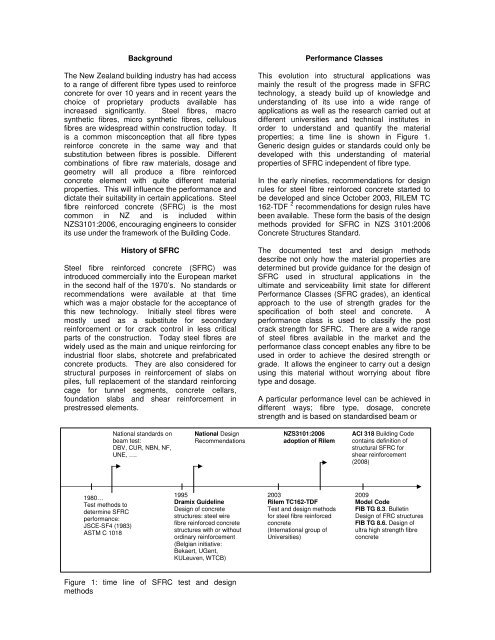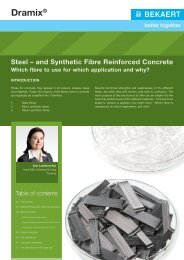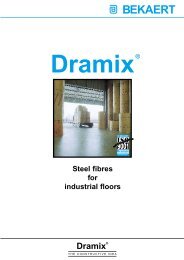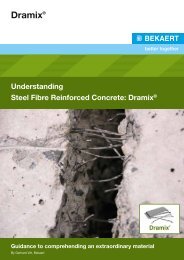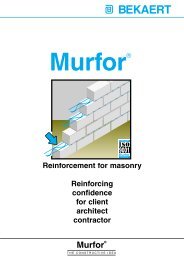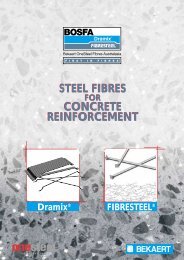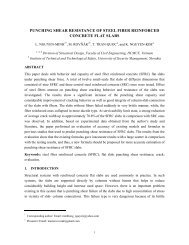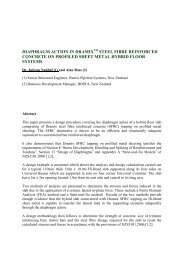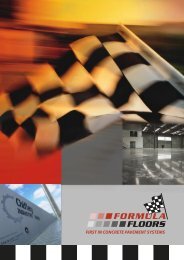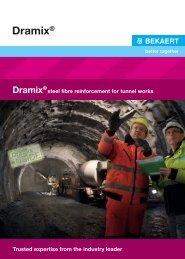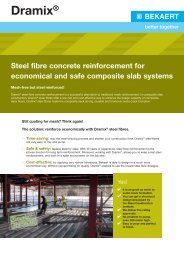Steel fibre reinforced concrete (SFRC) – Quality ... - BOSFA
Steel fibre reinforced concrete (SFRC) – Quality ... - BOSFA
Steel fibre reinforced concrete (SFRC) – Quality ... - BOSFA
You also want an ePaper? Increase the reach of your titles
YUMPU automatically turns print PDFs into web optimized ePapers that Google loves.
1980…<br />
Test methods to<br />
determine <strong>SFRC</strong><br />
performance:<br />
JSCE-SF4 (1983)<br />
ASTM C 1018<br />
Background<br />
The New Zealand building industry has had access<br />
to a range of different <strong>fibre</strong> types used to reinforce<br />
<strong>concrete</strong> for over 10 years and in recent years the<br />
choice of proprietary products available has<br />
increased significantly. <strong>Steel</strong> <strong>fibre</strong>s, macro<br />
synthetic <strong>fibre</strong>s, micro synthetic <strong>fibre</strong>s, cellulous<br />
<strong>fibre</strong>s are widespread within construction today. It<br />
is a common misconception that all <strong>fibre</strong> types<br />
reinforce <strong>concrete</strong> in the same way and that<br />
substitution between <strong>fibre</strong>s is possible. Different<br />
combinations of <strong>fibre</strong> raw materials, dosage and<br />
geometry will all produce a <strong>fibre</strong> <strong>reinforced</strong><br />
<strong>concrete</strong> element with quite different material<br />
properties. This will influence the performance and<br />
dictate their suitability in certain applications. <strong>Steel</strong><br />
<strong>fibre</strong> <strong>reinforced</strong> <strong>concrete</strong> (<strong>SFRC</strong>) is the most<br />
common in NZ and is included within<br />
NZS3101:2006, encouraging engineers to consider<br />
its use under the framework of the Building Code.<br />
History of <strong>SFRC</strong><br />
<strong>Steel</strong> <strong>fibre</strong> <strong>reinforced</strong> <strong>concrete</strong> (<strong>SFRC</strong>) was<br />
introduced commercially into the European market<br />
in the second half of the 1970’s. No standards or<br />
recommendations were available at that time<br />
which was a major obstacle for the acceptance of<br />
this new technology. Initially steel <strong>fibre</strong>s were<br />
mostly used as a substitute for secondary<br />
reinforcement or for crack control in less critical<br />
parts of the construction. Today steel <strong>fibre</strong>s are<br />
widely used as the main and unique reinforcing for<br />
industrial floor slabs, shotcrete and prefabricated<br />
<strong>concrete</strong> products. They are also considered for<br />
structural purposes in reinforcement of slabs on<br />
piles, full replacement of the standard reinforcing<br />
cage for tunnel segments, <strong>concrete</strong> cellars,<br />
foundation slabs and shear reinforcement in<br />
prestressed elements.<br />
National standards on<br />
beam test:<br />
DBV, CUR, NBN, NF,<br />
UNE, ….<br />
National Design<br />
Recommendations<br />
1995<br />
Dramix Guideline<br />
Design of <strong>concrete</strong><br />
structures: steel wire<br />
<strong>fibre</strong> <strong>reinforced</strong> <strong>concrete</strong><br />
structures with or without<br />
ordinary reinforcement<br />
(Belgian initiative:<br />
Bekaert, UGent,<br />
KULeuven, WTCB)<br />
Figure 1: time line of <strong>SFRC</strong> test and design<br />
methods<br />
NZS3101:2006<br />
adoption of Rilem<br />
2003<br />
Rilem TC162-TDF<br />
Test and design methods<br />
for steel <strong>fibre</strong> <strong>reinforced</strong><br />
<strong>concrete</strong><br />
(International group of<br />
Universities)<br />
Performance Classes<br />
This evolution into structural applications was<br />
mainly the result of the progress made in <strong>SFRC</strong><br />
technology, a steady build up of knowledge and<br />
understanding of its use into a wide range of<br />
applications as well as the research carried out at<br />
different universities and technical institutes in<br />
order to understand and quantify the material<br />
properties; a time line is shown in Figure 1.<br />
Generic design guides or standards could only be<br />
developed with this understanding of material<br />
properties of <strong>SFRC</strong> independent of <strong>fibre</strong> type.<br />
In the early nineties, recommendations for design<br />
rules for steel <strong>fibre</strong> <strong>reinforced</strong> <strong>concrete</strong> started to<br />
be developed and since October 2003, RILEM TC<br />
162-TDF 2 recommendations for design rules have<br />
been available. These form the basis of the design<br />
methods provided for <strong>SFRC</strong> in NZS 3101:2006<br />
Concrete Structures Standard.<br />
The documented test and design methods<br />
describe not only how the material properties are<br />
determined but provide guidance for the design of<br />
<strong>SFRC</strong> used in structural applications in the<br />
ultimate and serviceability limit state for different<br />
Performance Classes (<strong>SFRC</strong> grades), an identical<br />
approach to the use of strength grades for the<br />
specification of both steel and <strong>concrete</strong>. A<br />
performance class is used to classify the post<br />
crack strength for <strong>SFRC</strong>. There are a wide range<br />
of steel <strong>fibre</strong>s available in the market and the<br />
performance class concept enables any <strong>fibre</strong> to be<br />
used in order to achieve the desired strength or<br />
grade. It allows the engineer to carry out a design<br />
using this material without worrying about <strong>fibre</strong><br />
type and dosage.<br />
A particular performance level can be achieved in<br />
different ways; <strong>fibre</strong> type, dosage, <strong>concrete</strong><br />
strength and is based on standardised beam or<br />
ACI 318 Building Code<br />
contains definition of<br />
structural <strong>SFRC</strong> for<br />
shear reinforcement<br />
(2008)<br />
2009<br />
Model Code<br />
FIB TG 8.3. Bulletin<br />
Design of FRC structures<br />
FIB TG 8.6. Design of<br />
ultra high strength <strong>fibre</strong><br />
<strong>concrete</strong>


